From Ideas to Impact: GRI’s Founding Research Labs Celebrate 20 Years
By Martha Reilly
Good ideas can come from anywhere. Twenty years ago, they came from the Green Leafe Cafe, where Brad Parks’s honors thesis committee encouraged him to publish a book about his research on foreign environmental assistance.
“On one condition,” he responded. “You guys write it with me.”
The group, consisting of Parks ’03, Mike Tierney ’87, M.A. ’88, P ’15, Timmons Roberts, and Robert Hicks, began drafting on a napkin. Putting pen to unconventional paper brought Project Level Aid (PLAID) — now known as AidData — to life that day.
Just months later, another student posed a catalytic question at the Green Leafe. As Tierney’s research assistant, James Long ’03 used one of their check-ins to ask “Why do you teach International Relations so differently than you research it?”
While Long had seen many academics emphasize paradigms — such as realism — in the classroom, these very frameworks did not guide the research he had been working on that summer, which centered on international institutions and development. He wondered if this hypothesized “mismatch” was common across the discipline.
Tierney responded with open-mindedness: “Let’s see.”
And so a survey-driven research lab — the Teaching, Research & International Policy (TRIP) Project — was founded. In the early days, Long worked with Co-Principal Investigators Tierney and Sue Peterson to code journal articles for concepts, methods, and paradigms, from democratic backsliding to quantitative analysis to realism.
“Now, there’s natural language processing and machine learning to help with these things,” Long said. “But we humans had to figure this out 20 years ago.”
The growing team then developed over 70 questions so that IR scholars around the country could weigh in for themselves. The lab’s first survey received 1,084 faculty respondents who shared insights on the relationship between research and pedagogy, their personal sub-specialties, the influence of 9/11 on curriculum, and more. As the subsequent 2004 report reads, “We compare what we preach with what we teach.”
While analyzing results and strategizing next steps, the TRIP Project had good company in the basement of Morton Hall: Parks’s team of undergraduates, who were supplying critical data for PLAID’s forthcoming book, Greening Aid. Student researchers like Jess Jones ’05 coded donors’ spending behavior, aiming to understand why they gave foreign aid with positive or negative impacts on the natural environment.
“Very quickly, this became a database effort because we had to have data on what was being invested in,” Jones said. “But the available data was incomplete in a couple of different ways.”
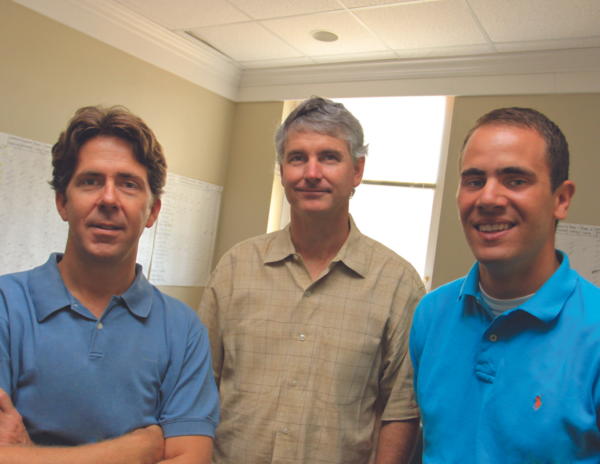
PLAID set multidisciplinary foundations early on. Inspired by an honors thesis from Brad Parks ’03 (right), Hicks (left), from William & Mary’s economics department, partnered with Tierney (middle) in government and Roberts (not pictured) in sociology to compile and re-categorize more than 430,000 individual aid projects from 1970 to 2000.
Big variations emerged in terms of quantity and quality of public information, Jones said. Donors like China and the Islamic Development Bank, for instance, were not reporting the number and purpose of loans and grants the same way — making it difficult to compare funding origins. Descriptions of the money’s purpose were sometimes thorough, but sometimes sparse or missing altogether. Jones recalls one instance where intent was described as a single line of text — something to the effect of “investing in democracy.”
“As a result, our focus became ‘Can we augment existing information with new sources to come up with a clear picture of what’s being done? Then can we develop a coding scheme to go through and categorize all of that funding according to a five-point scale of whether or not it’s environmentally friendly?’” she said.
But key information was not available at the click of a button in 2003. Students ordered critical documents, such as annual reports from development banks, through the inter-library loan service, Xeroxed these hard copies, and then scanned or manually entered content into the growing database.
At the time, all steps were leading toward the lab’s foundational goal: a book.
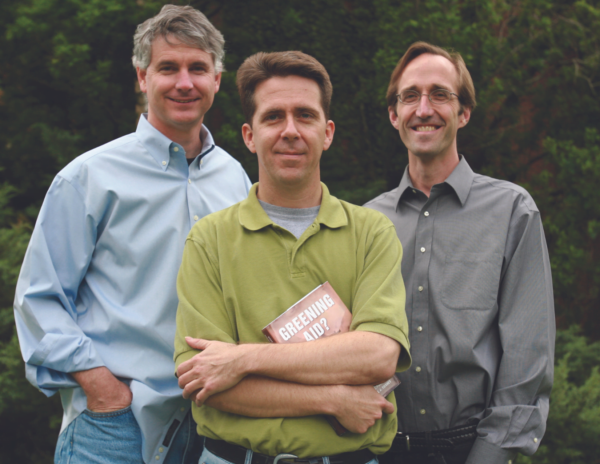
Mike Tierney, Timmons Roberts, and Rob Hicks pose with Greening Aid — a fulfillment of Project Level Aid’s original purpose. But the researchers didn’t stop there.
Gaining Collaborators
As the TRIP Project and PLAID were both charting new courses, student researchers bonded over the novel environment. The teams would watch Arrested Development together — sometimes throughout the work day, until Tierney told them that their productivity had plummeted, and they should just watch one episode during their 30-minute lunch.
Adding more students to the community was as much of a goal as adding more survey respondents. But standard recruitment efforts weren’t always what produced new team members.
“I vividly remember getting my [International Relations] midterm back from Professor Tierney, and it read ‘Come see me in my office,’” Richard Jordan ’10 said. “That is not what you want to hear. I was petrified that he thought I was cheating.”
Tierney assured Jordan that he had just given him the highest grade in his teaching history. He encouraged the then-sophomore to share his valuable opinions during class discussion more often, as Jordan usually sat in the back of the room and kept quiet.
“This really changed how I behaved,” he said. “I deliberately embarked upon a project of self-reformation. … I grew up on a farm in the middle of nowhere. I didn’t know what I was doing. I didn’t know what college was like, or how to use it to get ahead.”
A few months later, in late spring of 2008, Tierney shared more guidance.
“He asked me one day what I was doing over the summer,” Jordan recalls. “I said, ‘Oh, I don’t know — I’ll probably just go home and work in a bookstore or something like that.’ [Tierney] said ‘No, you’re coming to work for me and Dr. Peterson.’ And so I did.”
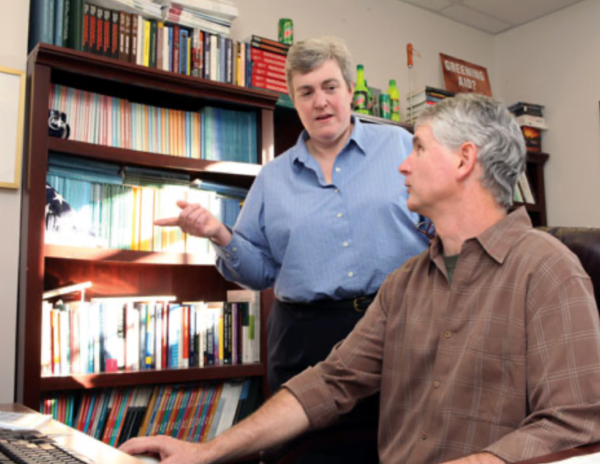
Peterson worked to define the TRIP Project’s research objectives and develop a trajectory for growth. Throughout her years of collaboration with Tierney, one goal was consistently the priority: student mentorship.
Jordan worked his way up to the position of Lead Research Assistant at the TRIP Project, after initially doubting that he had the experience or expertise to contribute well.
“I wondered, ‘Am I going to be living up to this expectation?’” he said. “[Tierney] went out of his way to make sure I knew that I was great. He really looked after me. I had no idea how anyone goes about entering this profession, no idea what one should do to pursue certain career paths. He made sure I had those directions — that I knew which steps I needed to take.”
A note sitting on Mike Tierney’s desk perfectly captures what happened next. In early 2023, Jordan wrote to say thank you. He had just earned tenure as a Professor of International Relations at Baylor University.
Full-circle moments like this have consistently defined the TRIP Project. Even after graduating in 2003 and moving to London and then San Diego, Long continued shaping the lab’s trajectory throughout his Master’s and PhD programs. Now a professor of Political Science at the University of Washington, he said “In every lecture I give, there’s a little bit of Mike Tierney and Sue Peterson’s wisdom coming out.”
A current Principal Investigator, Ryan Powers ’08, was one of the lab’s original student researchers who conducted early stages of contact collection, article coding, and data analysis.
After graduating in 2005, Jones returned too. But when she came back in 2008, PLAID and the TRIP Project shared much more than the same workspace.
A New Era
An assortment of external grants and contracts had sustained the labs for a few years at this point. But the biggest win yet emerged from within the university, once PLAID had completed its dataset and asked to present it to the Vice Provost in 2007.
“Right after that meeting, the Dean of Arts & Sciences Carl Strikwerda told us ‘I’m going up to New York to talk to people at the Rockefeller Foundation,” Tierney said. “He talked to them about our research, and they said it sounds like it would fit nicely with a new initiative from Hewlett and Gates.”
Subsequent introductions led to more presentations and more funding: $3 million from the Bill & Melinda Gates Foundation and $1 million from The William and Flora Hewlett Foundation.
“All we originally wanted to do was test hypotheses from sociology, economics, and political science,” Tierney said. “We never thought about the real world. After we built the dataset, people from the policy world realized it might have value to them, in terms of aid transparency, aid coordination, and aid effectiveness. We were like, ‘Really? They don’t care about cross-national time series analysis?’”
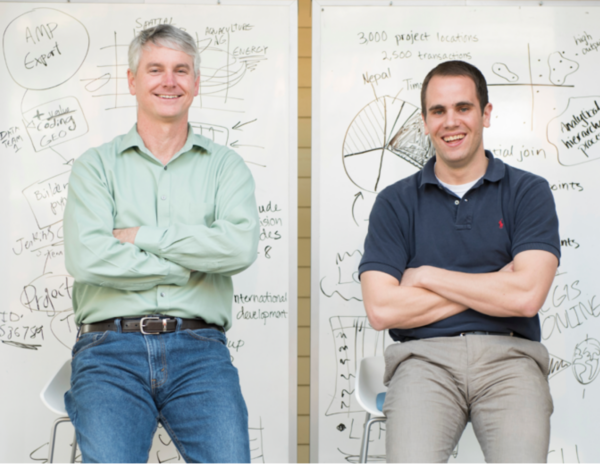
Though the TRIP Project and AidData were already sharing space, scaling the labs produced new avenues for sharing knowledge and resources. Mike Tierney (left) and Brad Parks (right) were key leaders in advancing this research environment.
This increased financial support led Tierney and Peterson to request a meeting with the Director of the Reves Center, the Dean of Arts & Sciences, and the Vice Provost for Research. They asked for 12,000 dollars to combine the TRIP Project and PLAID under one research umbrella with a centralized grant management system. The resulting Institute for the Theory and Practice of International Relations (ITPIR) expanded its audience beyond the ivory tower, aiming to inform public debate and policy practitioners.
“It wasn’t just research for research’s sake,” Jones, who worked as ITPIR’s Associate Director from 2008 to 2009, said. “All of a sudden, it was research for advocacy, which was sort of a mental shift from when the goal was to have an academic publication. There was a change in how we operated.”
Then based at Corner House on Jamestown Road, the ITPIR community had more than new challenges — it had new energy.
“There was a real sense of excitement from the labs,” Jones said. “I remember one time we had a party where we painted the stairs because we were just so thrilled to have a place where students could come and feel like they were part of something.”
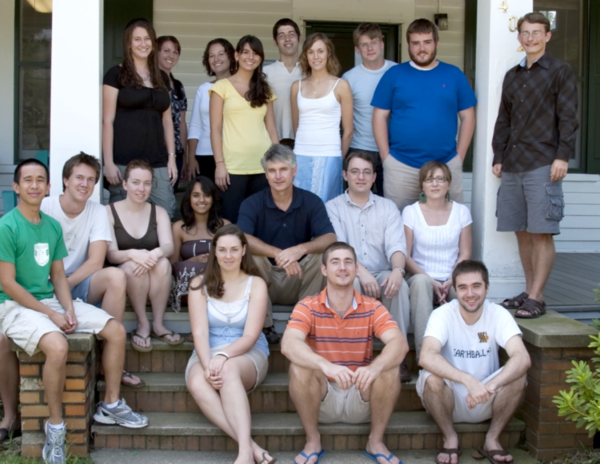
The PLAID research team gathers on the porch at the ITPIR Corner House.
Those researchers were laying the groundwork for practices that GRI, formerly ITPIR, still employs today — such as barbecues, open house events, cross-lab partnerships, and project management standards.
“One of the hardest things we had to do was learn how to fill out the template for a grant budget,” Jones said. “All of a sudden, it wasn’t just ‘How much money?’ but we actually had to cost out how much time we needed and what positions we wanted and for how long. There was a lot of learning.”
Now a Director in the Global Health division at an international development consulting firm, Jones recognizes the true scale of AidData’s evolution.
“I very much still think of this project as eight people in a computer lab,” she said. “It’s mind-blowing, in the most joyful way, to see where it’s gone. If you had told me [in 2004] that it would be as big as it is now, I would have laughed in your face.”
Leading the Way
While this on-campus network continued growing, the labs’ reputations spread far beyond Williamsburg. In 2009, Jordan attended an International Studies Association conference in New York. Before the flight, he asked Tierney to sit by the window so that he could see the view when landing, as he had never been on a plane before. A panel was prepared to share the TRIP Project’s new survey results, which documented how IR scholars around the world viewed the discipline’s purpose and substance.
“We got put in this tiny room that could hold ten people — basically a hotel room,” Jordan said. “[Tierney] insisted ‘People want to come to this.’ He raised a firestorm with the ISA administrators and told them that we needed to be in a big ballroom. We got moved to a space that could seat 200 people, and we filled all the chairs and had people standing.”
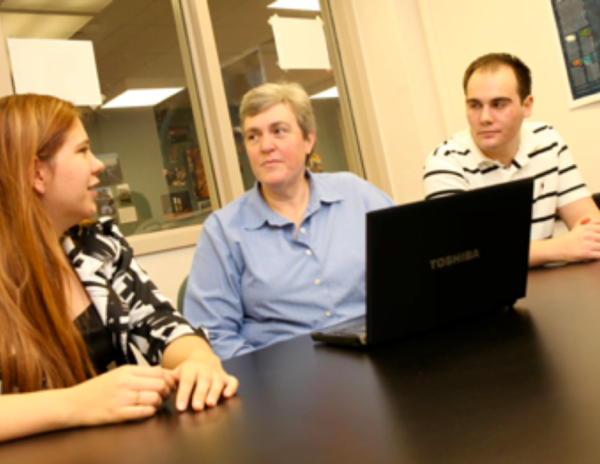
Peterson and students Lindsay Hundley (left) and Alex Atkins (right) discuss the TRIP Project’s 2011 survey of International Relations scholars in the U.S. and 19 countries. Sue Peterson (middle) helped the TRIP Project’s undergraduate attendees excel in new or unfamiliar environments.
Exceeding expectations became the norm at ITPIR, and that mentality trickled down to the students, Jordan said.
“Especially for PLAID, it was not at all obvious that it was going to work,” he said. “In fact, if you had asked [Tierney] in a candid moment, I think he would say a lot of people were pushing back and saying ‘What you want to do isn’t possible.’ But he was determined that no one was measuring aid in the way they needed to be, and we were going to be the ones to do it. Tierney’s a visionary.”
A culture of comfort and belonging emerged from this entrepreneurial approach. From going to movies together to making matching t-shirts to having craft nights, the TRIP Project and PLAID students found camaraderie.
“Things were very flat,” Tierney said. “There was no hierarchy. When we would have meetings, they included everybody: all faculty, all students, and staff members. Whether we had a meeting on the codebook or on our next paper, everyone was in the room together. We got to know people as our friends, not just as collaborators.”
And pranks were common. Students who house-sat while Tierney was traveling used a lawnmower to write “GO JETS!” — the rival to his favorite team, the Miami Dolphins — on his front lawn. At one point, PLAID students encouraged our IT expert to insert a randomizer into the data count, so that the person checking the number of lines coded would get a different result each time he refreshed the page.
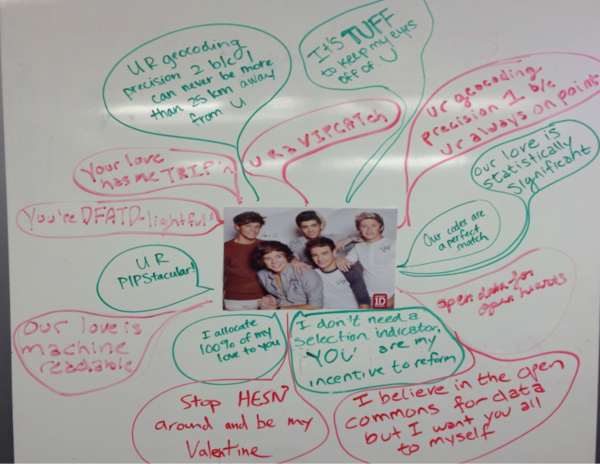
Aside from research, the teams continued to make memories through visits to berry fields in the summer, craft nights, and One Direction Valentine illustrations — pictured above.
“That’s the kind of stuff that happened all the time,” Jones said. “We just had so much fun with each other.”
As Never Before
But serious operations were still underway too. Over the four years that Alena Stern ’12 conducted research at both labs, ITPIR would change unimaginably.
In working with Parks, Stern wrote grants, designed a randomized control trial, and presented a paper based on the TRIP Project at the 2011 International Studies Association conference in Montreal.
“This level of work is the type of thing that typically only seasoned professionals have a chance to do,” Stern said. “Here I was, not even out of college yet, and having the opportunity to inform this research design and get to work with [Parks] as a true collaborator. That has always been so infused in the DNA of the TRIP Project, AidData, and the folks who lead those organizations.”
That same mentality guided ITPIR at a high point, when nearly a decade of innovative student-faculty partnerships began to pay. In 2012, AidData received the largest single award that had ever come into William & Mary: 25 million dollars from the Higher Education Solutions Network.
The United States Agency for International Development had created this initiative to establish institutional partnerships among development centers at seven top universities. Today in 2023, just one of those labs still remains: AidData.
But something besides longevity distinguished William & Mary early on.
“There was a big launch event in Washington D.C. to kick off the program,” Stern said. “Secretary Clinton and all these important people were there. Every other lab sent their most senior illustrious person to give a talk.”
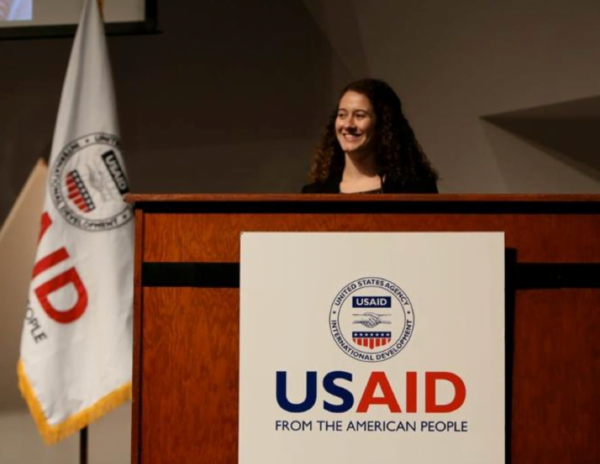
Becoming part of the Higher Education Solutions Network would allow AidData to geocode — linking its coding of aid information to real results on the ground, Stern noted during her speech at the USAID HESN launch event. Watch the video.
AidData sent Alena.
“This could have been a chance for [Parks] or [Tierney], but they said, ‘No we’d rather a student be in the spotlight,’” Stern remembers. “That’s a testament to the real attitude and mission of empowering undergrads. No matter how big the lab gets, that’s a core part of its identity.”
That grant infused support into every arm of ITPIR. The university used its portion to buy a yellow house on 427 Scotland Street — a new home base for the growing number of researchers — and to establish a Partnerships and Communications team within AidData.
Setting Foundations
As new team members joined, scenery changed, and portfolios expanded, AidData maintained a casual, unassuming presence on campus, Stern noted when she returned as a Program Manager in early 2013. For the first six months of that role,
she shared a desk with David Trichler, the newly-hired Director of Operations at AidData.
“When I joined, we were very much trying to figure out how to do research with partners who had a very high expectation for results, while staying true to our model and culture of working with students embedded in a liberal arts university,” Trichler said.
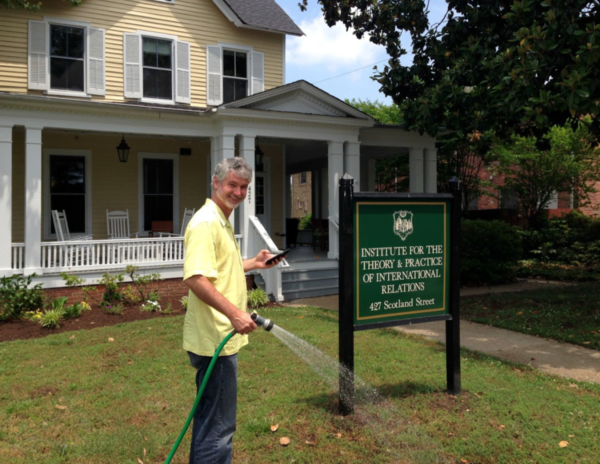
Tierney tends to the lawn of ITPIR’s new home base, a house on 427 Scotland Street, where countless barbecues and front porch chats would ignite new collaborations, research inquiries, and experiential learning opportunities for students.
AidData’s focus on mapping spatial data attracted the attention of government partners, international organizations, and other countries — such as Germany, Denmark, and the United Kingdom — who wanted to solicit the lab’s expertise for related services.
“HESN really let us bring William & Mary to the world and the world to William & Mary,” Trichler said. “We were also able to invest in new lines of research and bring in new areas of talent. … Our question was ‘How can we mine the data we have and use it to create new knowledge to understand the world better?’”
This expansion nearly a decade ago planted the seeds for AidData to lead at geospatial impact evaluations (GIE), which assess the cost-effectiveness and net effects of specific development interventions. Just last year, the lab received a 4.74 million dollar investment from the Bill & Melinda Gates Foundation to study climate-sensitive agriculture using GIE and Earth Observation. But throughout this major evolution, the lab’s practices have aligned with its founding multidisciplinary principles.
“It was fascinating when we hired an economist and data scientist,” Trichler said. “We deliberately put them next to each other, and you would hear their disagreements about how to approach a problem — one saying ‘This is how you look at the data’ and the other saying ‘But it doesn’t capture that variable. How about we try this?’ It was that contrast or that tension between different disciplines that led to breakthroughs.”
As AidData successfully used USAID’s funding to address pressing global problems, word spread. New partners, from the World Bank to the State Department, trusted these student-faculty teams.
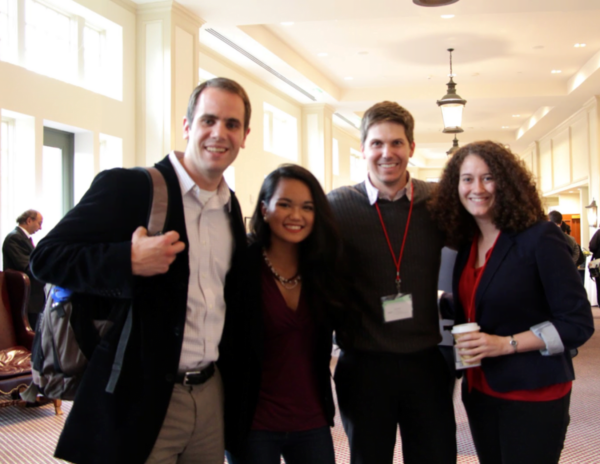
Trichler worked with AidData collaborators to bring the lab’s research to the real world, forging new partnerships along the way. The photo above captures team members (Parks, Pat Austria ’13, Trichler, and Stern) at a USAID conference hosted by W&M.
While the lab was tracking outcomes around the world, it also turned its attention inward, toward the William & Mary community. Stern designed the original iteration of the Summer Fellows Program, which still sends undergraduates around the world to conduct applied research with partner organizations.
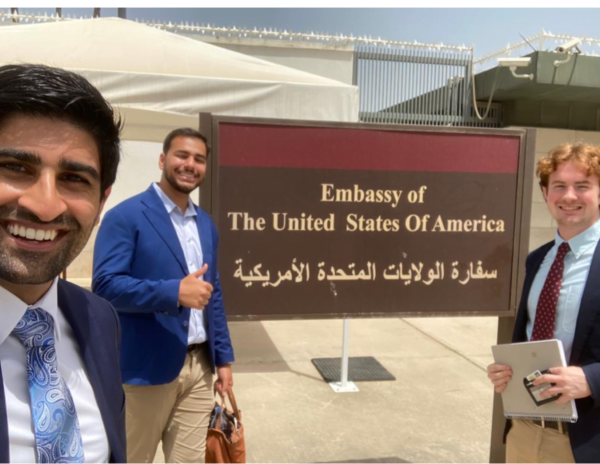
2022 Summer Fellows Ian DeHaven (right) and Salah-Dean Satouri traveled with GRI Affiliate Sharan Grewal (left) to Tunisia, where they assessed democratic backsliding and attitudes toward Kais Saied.
“It’s incredibly rewarding to have a sense that you’re building something that will last beyond your tenure,” Stern said.
Trichler had the same sense as he transitioned away from the AidData team in 2017, when ITPIR rebranded to the Global Research Institute, where he now works as Associate Director. Having spent years establishing professional development opportunities, Washington D.C. site visits, skill workshops and more, he continues learning about related outcomes years later.
“I still hear about the three-step process to interviewing that we would work with students on,” he said. “They’ll say ‘Hey, I just got my next job, and I used the AidData steps for my interview.’”
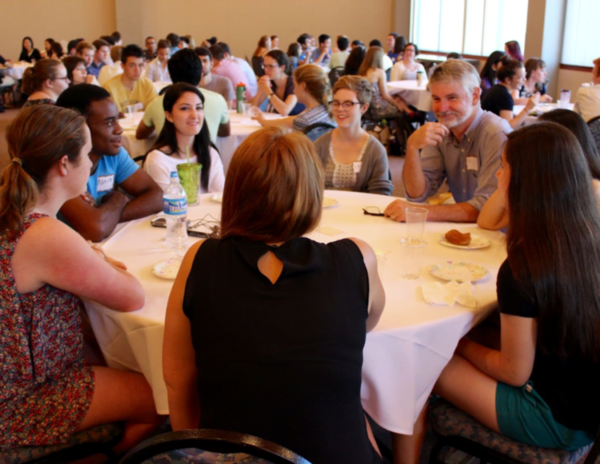
The Institute has always viewed student development and empowerment as key tenets of its mission. Tierney (pictured above with students) engages undergraduates through dinner seminars, coursework, site visits, mentoring sessions, and more.
Gaining Answers from Students’ Questions
While researchers identified ways to continue scaling, a student’s proposition — as always — led the way. Though AidData had successfully created a foreign aid database, the lab lacked a clear understanding of the fastest-growing donor and lender in the world: China. Chinese development finance remained shrouded in secrecy.
Upon returning home from his second study abroad experience in China, Austin Strange ’12 visited Parks’s office and asked “Is AidData doing anything in this space?”
The answer at the time was no. But the steps that followed have elevated this topic to the forefront of the lab’s identity and mobilized millions of dollars toward advancing research on China’s foreign assistance program.
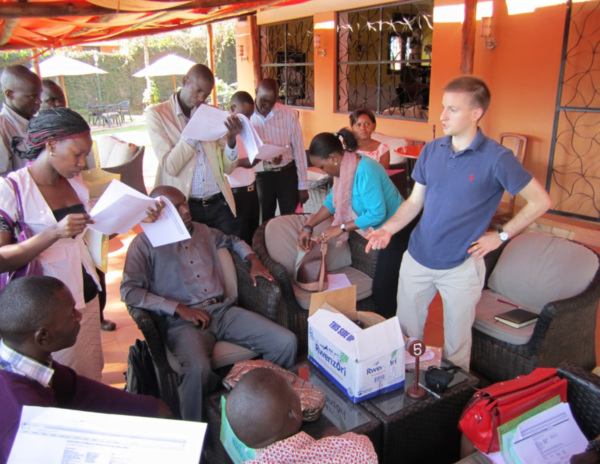
Strange traveled to Uganda, helping to groundtruth AidData’s methodology to ensure students in Williamsburg were indeed capturing accurate data thousands of miles away.
“He had an ambitious, even audacious idea to standardize and synthesize a lot of decentralized information in the public domain,” Parks said.
Refining this methodology over several years has positioned AidData as a leading expert on China’s overseas lending — along with associated implications, potential risks, and assessments of resulting debt.
Media features — including those in The New York Times, Washington Post, Wall Street Journal, Financial Times, and The Economist — have grown in number and frequency with the release of each report and dataset. Parks and his team have conducted briefings with key decision-makers at the highest levels of government and have been cited in numerous speeches from policymakers. Trevor Noah even integrated AidData findings about overdue debts into a segment of The Daily Show.
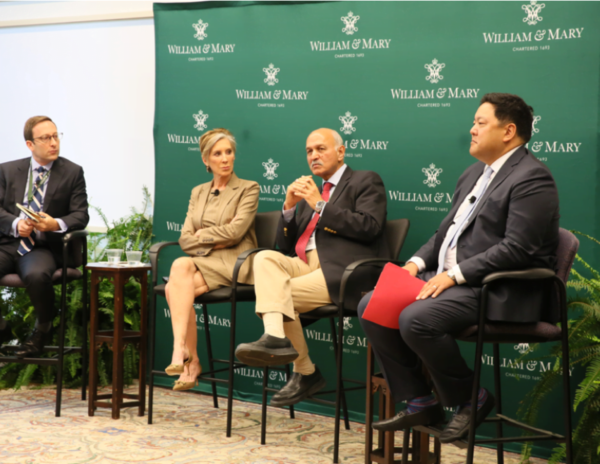
During the Institute’s 2022 conference on China’s global rise, Simon Rabinovitch engaged Carly Fiorina, Senator Mushahid Hussain Sayed and Ambassador Jason Chung in conversation about how U.S. economic statecraft functions in an era of contested cooperation with China.
“None of this would have happened if an undergraduate student didn’t ask for help in answering an important question and then get support from a faculty member who believes in him,” Tierney said. “[Parks] was paying it forward. He helped [Strange] to create new knowledge and build space for others to do the same. This is our comparative advantage.”
And unlike Parks’s original initiative, a book was not the goal. But this student-faculty team wrote one anyway. Banking on Beijing — co-authored by W&M alumni Strange, Tierney, and Parks — was published by Cambridge University Press in 2022 and has generated critical acclaim, including reviews published in leading outlets such as International Affairs, The China Journal, Economic Geography, and more.
“The book itself advances several lines of research in development economics and political science, but the real contribution is the collective good — an open source project level dataset that can be used by researchers from multiple fields, but also by journalists, activists, and policymakers,” Tierney said.
Innovating at 10 Years In
Recent years have proven just as formative for the TRIP Project’s evolution. Based on Long’s original codebook, researchers created the world’s most comprehensive database on IR journal articles, including extensive details on every article published in the 12 leading journals from 1980 onward.
But in 2013, the lab received a grant from the Carnegie Corporation of New York that altered the course of its data collection.
While researchers had conducted four major surveys by that point, this new funding enabled the TRIP Project to gather academic and expert opinion on current events through snap polls, Peterson said.
“The beauty of the snap polls is that we can get them into the field quickly and get results to decision-makers almost in real-time,” Peterson said at the time. “Because the information will reach policymakers quickly, these polls will contribute to policy debate and decision-making as international events unfold.”
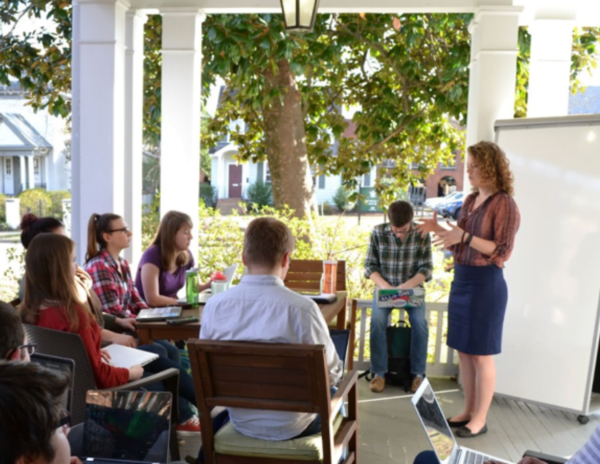
TRIP Project summer researchers have a team meeting during a season of rapid development for the lab.
A 2014 iteration gathered insights on whether Syria would relinquish its chemical weapons, the influence of the Sochi Olympics on Ukraine’s political crisis, and predicted outcomes of U.S. defense spending.
While informing policymaking on a larger and more direct scale, the lab still retained its original commitment to analyzing which factors influence IR teaching and research. A $1.3 million award from Carnegie and the MacArthur Foundation allowed the TRIP Project to continue innovating in both regards — and to send surveys to 12 new countries, including China, Russia, Brazil, and India.
As the TRIP Project was gaining new audiences, connections made at William & Mary — where it all started — guided each venture. Tierney and Peterson collaborated with their former students, Dan Maliniak ’06 and Ryan Powers to write a book, Bridging the Theory-Practice Divide in International Relations, which analyzes the conditions under which academic research shapes public policy. Now an Assistant Professor of Government at William & Mary, Maliniak collaborates with GRI’s Summer Fellows Program to advance research about the motivations behind the Georgian military serving in Iraq and Afghanistan.
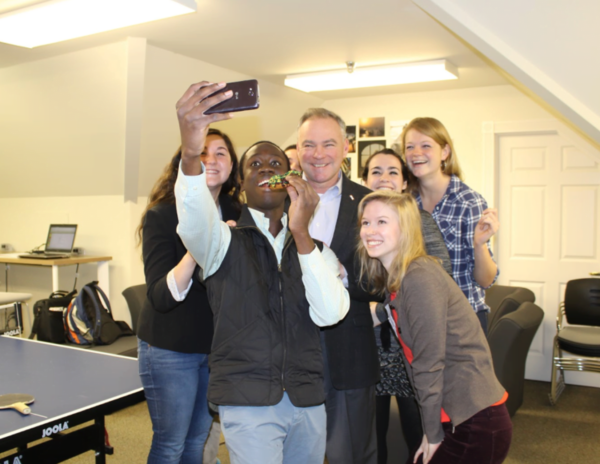
Student researchers pose with Tim Kaine during a 2014 visit. The Senator returned to the Institute in 2023 to connect with students from across labs and projects, and to learn from AidData about the implications of China’s approach to development finance. In his recent visit, he remarked “There’s a center of excellence here in these global labs where it’s not just about studying, but it actually is … about the creation of knowledge and usable data that can help us make policy.”
Meeting the Moment
Amid the past 20 year’s presidential transitions, international conflicts, economic uncertainty, and more, the TRIP Project’s research design has reacted to the outside world. From measuring how the pandemic affected instruction to assessing how the murder of George Floyd influenced class content, the lab has adapted its approach to meet pivotal moments.
“It’s always been a very news-aware process,” student researcher Mary Trimble ’23 said. “I think academia can sometimes feel insular … but at [the TRIP Project], you know exactly why what you’re doing matters.”
Through her four years as a student researcher, one purpose in particular has connected the different threads of Trimble’s work — from gathering contact information to keeping records to curating social media posts: aligning content with intended audiences.
“One thing that has just always stuck with me from one of the surveys that we did was that policymakers are about ten years behind the cutting edge of political science research,” she said. “Samuel Huntington’s Clash of Civilizations thesis, long after it had been kind of dismissed by the IR world, was still current in the halls of … the Pentagon and these other places.”
That key finding — along with many others — can inform strategy at every level of the Institute. A newly-launched program offers stipends to undergraduates who co-author op-eds with faculty members, illustrating GRI’s serious efforts to close this gap in research dissemination.
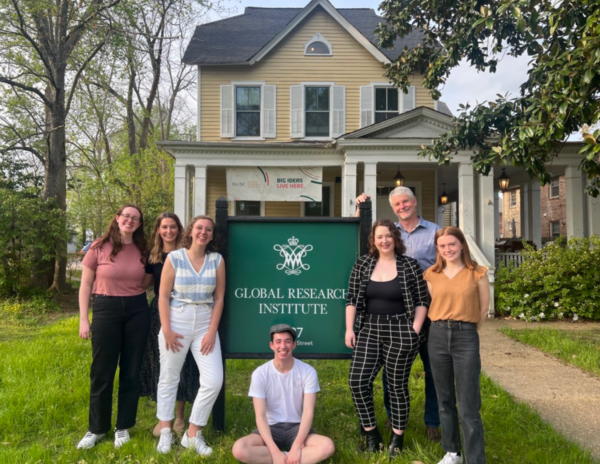
Members of the 2022-2023 TRIP Project team (including Trimble, directly left of the sign) gather in front of the Global Research Institute in April 2023.
“I see so much of what’s integral to GRI coming from or emerging within what [the TRIP Project] does,” Trimble said. “My own awareness of the way that research sort of enters the Zeitgeist and and becomes wisdom has definitely changed.”
Beyond new perspectives, Trimble said she has also gained novel skills.
“The willingness of my supervisors, at every point, to say ‘You can try that’ has definitely expanded my horizons beyond what I would have done if I just stayed in my academic world,” Trimble said. “I’m a French major — what other opportunity would I have to learn HTML?”
But mentorship has also come from peers.
“We have this really interdisciplinary environment where people are bringing lots of things to the table,” she said. “When I walked in the door at GRI, I knew those were my people. … Having smart, caring, kind teammates in your corner is just unbeatable.”
Long planted the seed for these outcomes 20 years ago by asking a candid question at the Green Leafe Cafe. What’s sprouted since has advanced empowerment in Williamsburg and in Seattle, where he now teaches.
“I tell my students all the time ‘You might get a great idea just talking to someone over coffee for an hour,’” Long said. “You’re probably not going to get a great idea listening to me lecture you. The way that [Tierney] and [Peterson] have built the communities to interact with each other is the most important thing they’ve done. It’s why they’re able to tackle so many problems, because they’re not a bunch of siloed individuals.”
Big Ideas Live Here
Now consisting of ten labs, employing over 200 student researchers, generating front page coverage in The New York Times, and conducting speaking engagements at the White House, the Institute may seem nearly unrecognizable from its origins. But the atmosphere at its two founding labs prove that while times and means have changed, priorities have not.
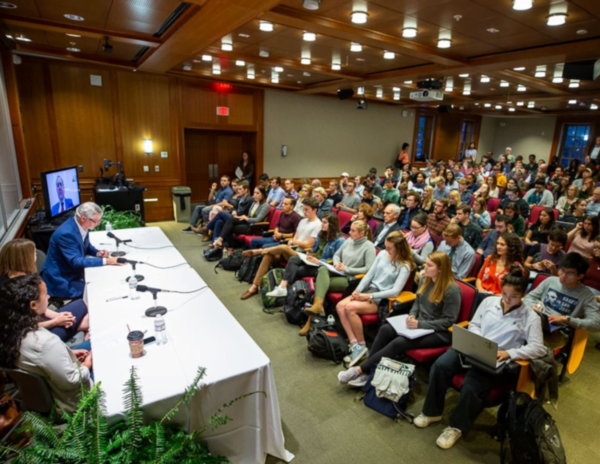
The TRIP Project bridges gaps while engaging undergraduates in novel learning opportunities. In 2019, the lab hosted a conference to foster dialogue between journalists and academics.
In early 2023, just days separated the Institute’s crawfish boil event from a visit with Senator Tim Kaine. A closet on the third floor contains notebooks for esteemed visitors and conference attendees, along with Goldfish and potato chips for students who want to study or do homework at GRI. Investing in both community and research has come naturally because the latter was built upon the former — ideas for the TRIP Project and AidData emerged only after professors and students were celebrating and connecting at the Green Leafe Cafe.
“Science is truly social,” Long said. “Being an important thinker and doer in the world is not a solo effort. If you look at how things are solved in the real world, it’s very rarely someone like Archimedes sitting in a bathtub and having a ‘eureka!’ moment. It’s usually people getting together, hashing out their ideas, and working toward a solution. Our most pressing global problems require that.”
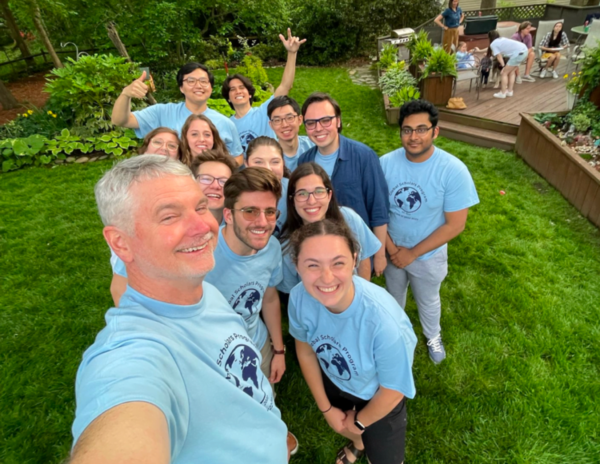
Tierney takes a selfie with students at his house for an end-of-semester barbecue celebration.
Over the next 20 years, GRI must balance two priorities: continuing to support existing projects and trusted partners, while also innovating and meeting new challenges. The Institute will also work to bring the liberal arts and sciences into labs, processes, and paths forward.
“There’s a risk for research institutions in universities to rest on their laurels if they don’t focus on the culture and the attributes that led them to success,” Trichler said. “I want to continue to create a space for investing in new ideas from students and faculty. Most will fail, but some will hit and be anchored.”
Many new projects, and the two initial ones launched in the summer of 2003, were only possible because of generosity from William & Mary alumni.
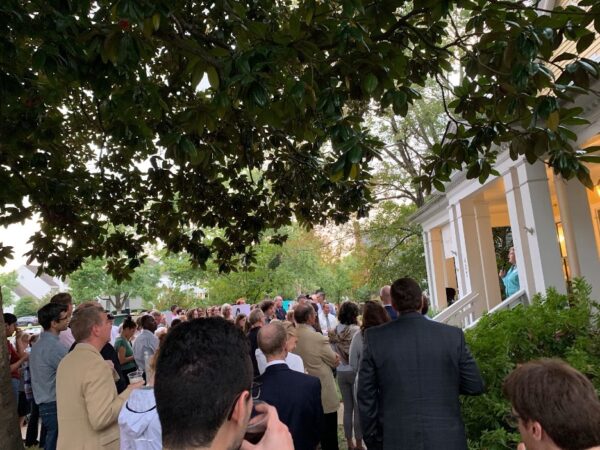
Each year, GRI’s Homecoming BBQ offers a chance for reconnection among alumni, community members, and current students. Above, a crowd gathers to hear updates.
Current community members support GRI projects philanthropically, but also by hiring interns, connecting faculty to grant funding opportunities, and helping to disseminate GRI research findings. In fact, it was a gift from Tierney’s undergraduate tennis teammate and double’s partner, Ben Berinstein, that paid research stipends for Parks and Long at the very beginning, during the summer of 2003.
“Without his financial support, none of this would have ever happened,” Tierney said.
The Institute’s research is designed to be applied — informing decisions and understandings at government agencies, NGOs, and private companies. But an equally important outcome involves nurturing students for years to come.
“Wanting everyone’s voice to be heard — no matter their title, no matter their seniority — is something I’ve really tried to take with me and have found very influential in my professional career,” Stern said. Now the Associate Director of Data Science at the Urban Institute, she imagines “Undoubtedly, I’m one of many former students who would tell a similar story.”
Comments are currently closed. Comments are closed on all posts older than one year, and for those in our archive.

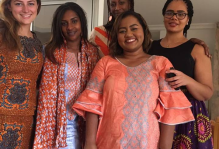
I found something in various sizes less than a ball point pen ball tip in each size. And they flat in rock and with sharp pointed hairs around each spherical shapes edges.